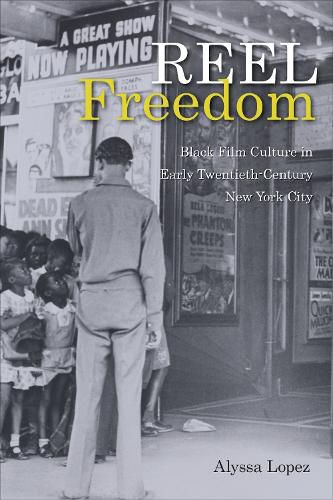Readings Newsletter
Become a Readings Member to make your shopping experience even easier.
Sign in or sign up for free!
You’re not far away from qualifying for FREE standard shipping within Australia
You’ve qualified for FREE standard shipping within Australia
The cart is loading…






Reel Freedom intimately captures the relationship between Black film culture and space in New York City. Alyssa Lopez argues that Black film culture, from its origins in the early twentieth century to its firm establishment in the 1930s, was necessarily both entertainment and resistance, connected as it was to Black New Yorkers' demands for access and equality in the city. Lopez investigates how ordinary people, labor activists, journalists, filmmakers, theater managers, and owners all shaped Black film culture. Black girls and women used moviegoing as a means of independence and control over their lives. Race filmmaker Oscar Micheaux fought with New York State's censorship board to get his films screened with limited edits in local theaters. And Harlem's Black projectionists battled for unionization and fair pay, while journalists linked cinema to Black New Yorkers' lived experiences.
In Reel Freedom, Lopez chronicles the wide-ranging and remarkable pervasiveness of Black film culture in New York City, redefining a period and place most associated with the Harlem Renaissance. In doing so, she illustrates how Black New Yorkers leveraged cinema to make the city their own and to enjoy urban living to its fullest.
In the series Urban Life, Landscape, and Policy
$9.00 standard shipping within Australia
FREE standard shipping within Australia for orders over $100.00
Express & International shipping calculated at checkout
Reel Freedom intimately captures the relationship between Black film culture and space in New York City. Alyssa Lopez argues that Black film culture, from its origins in the early twentieth century to its firm establishment in the 1930s, was necessarily both entertainment and resistance, connected as it was to Black New Yorkers' demands for access and equality in the city. Lopez investigates how ordinary people, labor activists, journalists, filmmakers, theater managers, and owners all shaped Black film culture. Black girls and women used moviegoing as a means of independence and control over their lives. Race filmmaker Oscar Micheaux fought with New York State's censorship board to get his films screened with limited edits in local theaters. And Harlem's Black projectionists battled for unionization and fair pay, while journalists linked cinema to Black New Yorkers' lived experiences.
In Reel Freedom, Lopez chronicles the wide-ranging and remarkable pervasiveness of Black film culture in New York City, redefining a period and place most associated with the Harlem Renaissance. In doing so, she illustrates how Black New Yorkers leveraged cinema to make the city their own and to enjoy urban living to its fullest.
In the series Urban Life, Landscape, and Policy